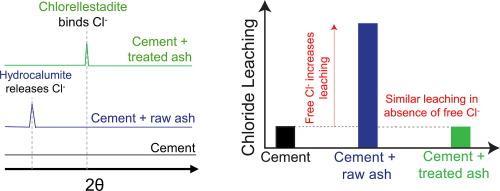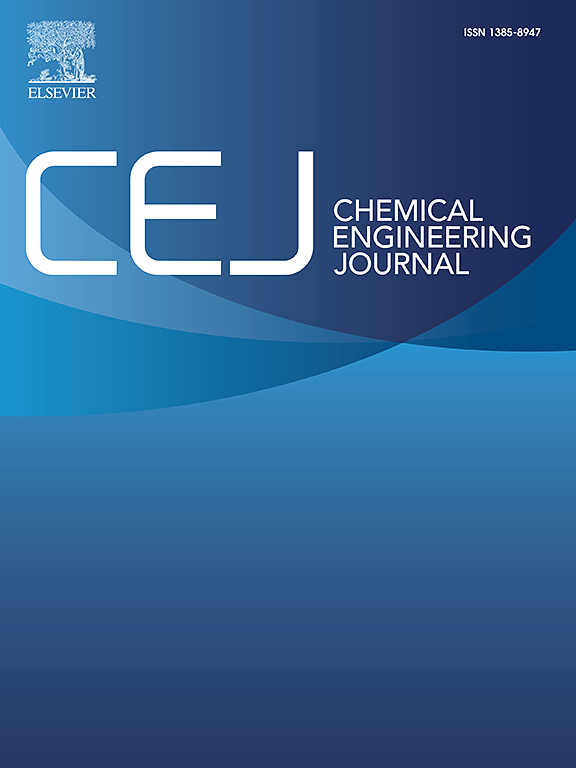Chlorellestadite-enriched waste-to-energy fly ashes in cementitious systems: Implications of ash treatment on end use
IF 13.3
1区 工程技术
Q1 ENGINEERING, CHEMICAL
引用次数: 0
Abstract
Waste-to-energy (WTE) plants generate fly ashes that are often destined for the landfill. These ashes are rich in chlorine, zinc, and various heavy metals. Here, we investigate the feasibility of their incorporation within cementitious systems in the context of a novel treatment process that chemically binds chlorines into chlorellestadite. Untreated ashes enhance the hydration kinetics and strength, likely due to excess Cl. However, the treated ashes retard the hydration because of the presence of ZnO (2–6 wt%). This retardation was successfully mitigated with up to 2 % calcium nitrate additive, resulting in cement-ash pastes that had mechanical strength comparable to 100% cement pastes. The untreated ashes leached excess Cl and led to the precipitation of hydrocalumite, whereas the treated ash–cement pastes were free from this phase. Finally, for ashes incorporated in hardened cement pastes, the leaching of heavy metals such as Pb and Cr was well under the toxicity limit, for both treated and untreated ashes. In summary, untreated ashes may find end use in unreinforced concrete applications, and treated ashes may be used within reinforced concrete, at least up to 10% cement replacement level.

水泥基系统中富含氯雷他定的废物变能源粉煤灰:灰烬处理对最终用途的影响
垃圾发电厂(WTE)产生的飞灰通常会被送往垃圾填埋场。这些灰烬富含氯、锌和各种重金属。在此,我们研究了将这些灰烬纳入水泥基系统的可行性,并采用了一种新的处理工艺,将氯化学键合到绿泥石中。未经处理的灰烬可提高水化动力学和强度,这可能是由于过量的氯所致。然而,由于氧化锌(2-6 wt%)的存在,经过处理的灰烬会延缓水化。使用最高 2% 的硝酸钙添加剂可成功缓解这种延缓作用,从而使水泥灰浆的机械强度与 100% 水泥灰浆相当。未经处理的灰烬会沥滤过多的 Cl,并导致氢钙石沉淀,而经过处理的灰烬水泥浆则不存在这一阶段。最后,对于掺入硬化水泥浆中的灰烬,无论是经处理的灰烬还是未经处理的灰烬,重金属(如铅和铬)的沥滤量都远低于毒性极限。总之,未经处理的灰烬可最终用于非钢筋混凝土应用,而经处理的灰烬可用于钢筋混凝土,至少可达到 10%的水泥替代水平。
本文章由计算机程序翻译,如有差异,请以英文原文为准。
求助全文
约1分钟内获得全文
求助全文
来源期刊

Chemical Engineering Journal
工程技术-工程:化工
CiteScore
21.70
自引率
9.30%
发文量
6781
审稿时长
2.4 months
期刊介绍:
The Chemical Engineering Journal is an international research journal that invites contributions of original and novel fundamental research. It aims to provide an international platform for presenting original fundamental research, interpretative reviews, and discussions on new developments in chemical engineering. The journal welcomes papers that describe novel theory and its practical application, as well as those that demonstrate the transfer of techniques from other disciplines. It also welcomes reports on carefully conducted experimental work that is soundly interpreted. The main focus of the journal is on original and rigorous research results that have broad significance. The Catalysis section within the Chemical Engineering Journal focuses specifically on Experimental and Theoretical studies in the fields of heterogeneous catalysis, molecular catalysis, and biocatalysis. These studies have industrial impact on various sectors such as chemicals, energy, materials, foods, healthcare, and environmental protection.
 求助内容:
求助内容: 应助结果提醒方式:
应助结果提醒方式:


